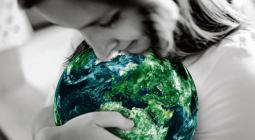THE CHANGING CLIMATE

For the recent years, the world has experienced extreme weather events evidenced by hurricanes in the northern part of the world, extreme heat waves up to 45 degrees Celsius and more, cold scaps with temperatures falling below -15 degrees celcius,typical cyclones with 85 to 90 mile-per-hour winds, drought at the Horn of Africa and torrential rains that accumulates at a rate of 0.3 inches per hour. The major cause of these disasters is the change in climatic conditions as a result of greenhouse gases. The extreme weather events have cause severe losses of lives and property affecting greatly the society and economy of the nations. These consequences vary from wild fires, flooding, famine to mention but a few. The report by the UNEP and GRID-Arendal said climate change and land-use change could lead to a sharp rise of fires by up to 50 per cent by the next century. Extreme fires will go up by 14 per cent by 2030, 30 per cent by the end of 2050 and 50 per cent by the end of the century.
In 2020, wildfires consumed large chunks of the Tsavo conservation area and destroyed more than 800 square kilometers and in March 2022, fire breaks in in Mount Kenya, Aberdares and Kirisia destroying the biodervisity and putting the adjacent communities at a greater risk. Creating fire breaks and arresting the raging fires has become a very expensive affairs where millions have to be injected to save lives, property and the biodiversity.
THE CHANGE IS WOMANǃ

Who/what is the major contributor to climate change? Humans are responsible for climate change largely due to the greenhouse gas emissions. The use of fossil fuel in vehicles which accounts to approximately 14% of total greenhouse gas emissions to agriculture which accounts for 24% of global greenhouse gases. These emissions get into the atmosphere increasing the global temperature and as a result causing global warming.
The UNFCCC recognizes vulnerable groups, community and ecosystems as the most affected by climate change, with a special focus on women. The adverse effects of drought, floods, hurricanes, extreme rainfall events and sea level rise are often felt more by women than men as a result of gender discrimination and societal expectations related to gender roles. Therefore, what is the role of women in tackling climate change? Women are mostly recognized as the sustainable resource managers and climate leaders. They rely mostly on the natural biodervisty to take care of their families and when disaster strikes they are the ones who carry the care burden as they look for survival means for their children. The recent COP27 saw a major focus on gender and climate change. The UNFCCC secretariat analyzed Parties’ 2022 Nationally Determined Contributions (NDCs) and found that 90% included significant mention of gender. This showed a continued increasing trend in gender integration in NDCs. Most Parties committed to implementing gender-responsive climate policies ,inclusion of women during public consultations and engagement processes, and affirmed commitment to gender equality. So can we now confidently say The Future is Woman?

Women are perceived to be the most vulnerable and are highly affected by the changes in climatic conditions. Security of our women and girls has been alarming especially in the rural regions and less advantaged regions of the world. In Kenya, the recent drought has resulted in more insecurity as women are left vulnerable in the hands of perpetrators who devour them mercilessly. Cases of women leaving their homes to search for food and water for their children subjecting them to perpetrators along the way who take advantage of their vulnerability, some young girls are seen barter trading with their bodies for food and water and some even falling victims of early marriages to save their families from hunger crisis.

Women made up of less than 34% of Country negotiating teams at the UN Summit in Egypt.’
How far are we from attaining gender justice? UNFCCC has recognized the plans of Parties to mainstream gender in their NDCs.This means priotizing the women. There has been recent talks on the need to have gender disaggregated data in all social and economic sectors. The presence of such data will help to analyze the issues affecting the different gender for better understanding of the impacts imposed on them , their resilience and adapting ability to these impacts. There is also a need to implement gender responsive climate policies all sectors. This means providing opportunities for women leadership in climate related issues through education and the inclusion of more women in the climate negotiating tables. COP26 highlighted the need to improve the representation and leadership of women at the COP, however according to BBC analysis of COP27, women made up of less than 34% of Country negotiating teams at the UN Summit in Egypt.
It is time for the woman to claim her spaceǃ

How about we adopt this one rule by some of the communities in Marsabit where there is no meeting which is started without reaching at least a quarter of the quorum being women? This means women are being given more opportunities to participate in decision making platforms. Lately, there has been many women groups being formed in the climate spaces. Women are rising up to form movements that will bring change. Evidence being seen at the Coastal regions where we find women conserving mangroves along the Tudor Creek and others cultivating sea grass in Kwale as a source of alternative livelihood. The society now considers women as the agents of change. In conclusion, the space has been created, the capacity needs to be built, women need to take up their spaces .It is our voice that we need to amplify to make known our needs to the world and ensure that they respond to them accordingly.
It is time to claim our spaceǃ
Nancy Cheki
Gender & Climate Change Advocate




